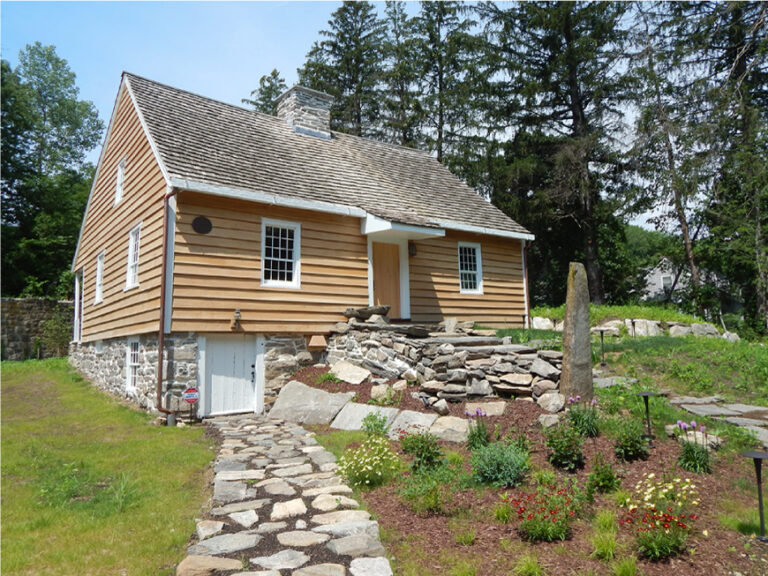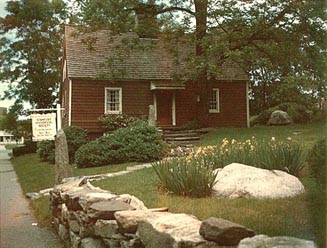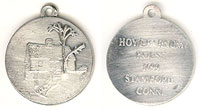
It was relocated in November of 2016 to increase its accessibility to the public and to allow for the construction of a new Stamford Police Headquarters downtown.
Originally built in 1699 by Samuel Hait (or Hoyt), this is the oldest authentic residence in Stamford. The house contains artifacts from the 18th and 19th centuries, as well as reproduction items that you can touch! An introductory video, an audio tour and informative signage will whisk you away to old Stamford and a self-guided visit.
The Hoyt Barnum House, due to ongoing repairs, will be closed indefinitely. We are sorry for the inconvenience. Once repairs are completed, we will post that the House has reopened. Thanks so much for your understanding.
Tours are available Thursday and Friday at 12:30, 1:30 and 2:30; Saturdays at 11, 12, 1:30 and 2:30. You may also make an appointment to see the house outside of our regular hours. Tours are limited in size.
Groups of more than 10 people must be booked in advance. Tickets are $5/person (cash or check) and include an audio guide. Children under 12 are free with a paying adult. Children must be supervised at all times.
The people who built this house were the children or grandchildren of the founders of Stamford. Their tastes and their sense of relation to England were beginning to change and they were becoming more independent. They adopted English architectural styles into a more American mode.
Most of the houses in New England“ and in Stamford“ were built of wood because it was difficult to make mortar to hold stone together without lime, and lime was in short supply in Stamford. The fireplaces and chimneys were put together with clay and hair, or whatever binder could be found for use with the readily available clay.
In building the house, the central chimney was built up to the level of the first floor. Then the house was framed. The framing was done on the ground, the timbers that joined together were marked with matching numerals. To raise the house, a line of men with long poles would push up one side, another line of men would push up the next side. Wooden pins were then used to hold the sides together.
Once the framing was the done the owner (Samuel Hait) finished the structure, probably with the help of family members.
The house is braced frame construction, (post and beam). The foundation is of stone. The large vertical members are called posts, and the horizontal beams lie on them.
The parlor is plastered. The bedroom is whitewashed and the common room walls are sheathed with wood paneling, thus showing the various finishing techniques incorporated into the house during it’s evolution.
A Center for History, Culture and Tradition: A Case for History
Mayor declared October 2, 2004 Hoyt Barnum House Day
Reprints from :


This pewter pendant, designed by whitesmith Jim Freebairn, who volunteers as a docent at the house, may be purchased at the Society for $5. Approximately 1 3/8″ in diameter, it can be used as a pendant or a holiday ornament.
Photos © Stamford History Center
Why Do We Need A History Center?
The Stamford History Center helps people know about, experience and value their own and the region’s history, culture and traditions so that this understanding may enhance their experience of the present and the future. The lessons of the past offer much to solve the problems of the present and prepare for challenges to come.
For children to grow up whole, and ready to take their places in the world, they must have assets: not stock certificates, but the personal assets of healthy self-esteem, appreciation for their origins, feelings of connectedness, belonging, and responsibility to a larger community. These inner resources help them withstand the pitfalls of growing up, expand their understanding of what they might accomplish, and strengthen them to pursue a future full of promise. It is precisely because we must address society’s urgent problems of today that we look to our history, culture and traditions.
To understand the importance of cultural tradition, one need only compare the experience of religious groups who came to this country to exercise their traditions freely with that of people indigenous to North America and people brought to this continent against their will, both of whose cultural traditions were broken down by outside forces.
As technology depersonalizes the way we live, work, communicate and relate to one another, it expands the importance of being able to see in the flesh the wonders of what used to be. Research on the Internet can never produce the awe of seeing the real life diaries of a Civil War veteran or the relics of how ancestors experienced defining moments in their lives. As corporations move us from place to place around the country and the world, the connection of history brings us closer to community and to home. It is the role of History and of this organization to give our children, and their elders, a sense of being part of a continuum that began with the dawn of civilization and will continue with their own progeny; we help them recognize the value of their own and others’ ancient cultures: we encourage them to find and cross a bridge between the past and the present and use this understanding to construct their own bridges to the future; we give them a sense of family and societal traditions; and a feeling of being an integral part of the human community.
A Community Partnership
As an independent nonprofit organization, The Stamford History Center depends on the commitment, involvement and contributions of the generous community it serves. Its remarkably rich array of programs and services is supported by a modest annual budget. Program-related income – membership dues, admissions, special events, seminars and Thrift Shop sales – provides about half the funds needed to sustain the current level of programming. The other half must be raised each year in contributions from individuals, businesses, foundations and community organizations.
The City of Stamford provides the location for our Center for History, Culture, and Tradition in the 1914 building that was first the Willard School and later the Martha Hoyt School at 1508 High Ridge Road.
A number dedicated and knowledgeable volunteers give countless hours of their time each year to make programs and facilities fascinating and easy-to-use. They are rigorously trained as professionals to offer assistance with research, conduct tours, present programs, and work to conserve the permanent collection. They organize community events that draw hundreds of children and adults into first-hand experiences of moments in times past.
The society’s operation depends mainly on volunteers – !
The History Center’s website is the primary gateway for public access to the tremendous wealth of our historical resources:
The is a specialized collection dealing in depth with the history of Stamford, from pre-settlement to the present. Its holdings consists of books, pamphlets, periodicals, and boxed manuscript materials dating back as far as the 17th century. A number of its material or lists thereof are . A work in progress is adding our book holdings to the online catalog of the . The hold over 10,000 images, dating back to Civil War times, in a wide variety of formats.
The History Center has a presence on .
We ask you to join in partnership with the History Center by becoming a member, by volunteering your time and talent, by actively participating in programs, and by offering your financial support to assure that this first century of achievement will provide the foundation in history, culture and tradition for the people of Stamford in the next century.